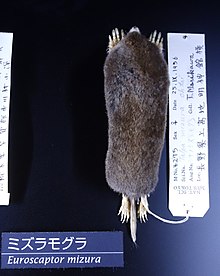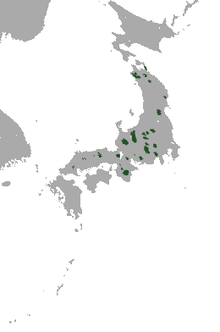Japanese mountain mole
| Japanese mountain mole | |
|---|---|

| |
| Scientific classification | |
| Domain: | Eukaryota |
| Kingdom: | Animalia |
| Phylum: | Chordata |
| Class: | Mammalia |
| Order: | Eulipotyphla |
| Family: | Talpidae |
| Tribe: | Talpini |
| Genus: | Oreoscaptor Kawada, 2016 |
| Species: | O. mizura
|
| Binomial name | |
| Oreoscaptor mizura (Günther, 1880)
| |

| |
| Japanese Mountain Mole range | |
| Synonyms | |
|
Euroscaptor mizura | |
The Japanese mountain mole (Oreoscaptor mizura) is a species of Old World mole in the family Talpidae. It is endemic to Japan. It is the only member of the monotypic genus Oreoscaptor. Its natural habitats are temperate forests and temperate grassland.
Taxonomy
Although the Japanese mountain mole was formerly classified in the genus Euroscaptor, a study published by the American Society of Mammalogists found that they did not truly belong to the genus because of earlier evolutionary divergence from other Euroscaptor species.[2] In 2016, the species was reclassified into the new genus Oreoscaptor.[3][4]
Morphology
The taxonomic position of the species was reassessed in 2016 based on its external and skeletal morphologies. It was found that the muzzle of this species showed a unique groove on the ventral side, separating it from the rest of the moles in the family.[2][3]
References
- ^ Laginha Pinto Correia, D. (2016). "Euroscaptor mizura". IUCN Red List of Threatened Species. 2016: e.T8385A22320533. doi:10.2305/IUCN.UK.2016-1.RLTS.T8385A22320533.en.
- ^ a b Shinohara, Akio; Kawada, Shin-ichiro; Son, Nguyen Truong; Koshimoto, Chihiro; Endo, Hideki; Can, Dang Ngoc; Suzuki, Hitoshi (2014-06-26). "Molecular phylogeny of East and Southeast Asian fossorial moles (Lipotyphla, Talpidae)". Journal of Mammalogy. 95 (3): 455–466. doi:10.1644/13-mamm-a-135. ISSN 0022-2372.
- ^ a b Kawada, Shin-ichiro (2016). "Morphological Review of the Japanese Mountain Mole (Eulipotyphla, Talpidae) with the Proposal of a New Genus". Mammal Study. 41 (4): 191–205. doi:10.3106/041.041.0404. ISSN 1343-4152. S2CID 88959277.
- ^ "Explore the Database". www.mammaldiversity.org. Retrieved 2021-10-09.
| Euroscaptor mizura | |
|---|---|
| Talpa mizura | |
- Articles with short description
- Short description matches Wikidata
- IUCN Red List least concern species
- Articles with 'species' microformats
- Commons category link is on Wikidata
- Taxonbars with automatically added original combinations
- Endemic mammals of Japan
- Talpidae
- Taxonomy articles created by Polbot
- Mammals described in 1880
- Taxa named by Albert Günther
- Taxobox binomials not recognized by IUCN
- All stub articles
- Eulipotyphla stubs
